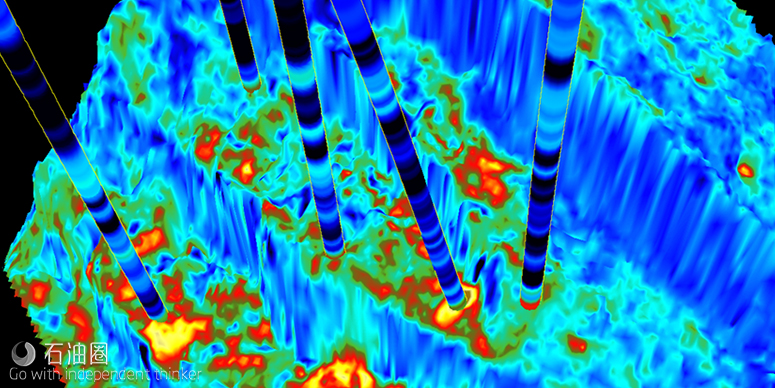CGG announces that GeoSoftware, part of its Geoscience Division, has launched a new generation of cloud-ready reservoir characterization solutions. Jason 10.0, HampsonRussell 10.4 and PowerLog 10.0 also feature advanced machine learning capabilities and greater cross-product integration, improving E&P project performance and providing a better understanding of reservoir properties.
The three new releases already run seamlessly on Microsoft Azure’s Cloud Environment and will soon be available on other major Cloud platforms. Geoscientists can now implement compute-intensive workflows and run very large projects, to process thousgands of wells, faster than ever before.
The benefits of machine learning continue to drive new capabilities to address complex geological challenges. HampsonRussell Emerge now delivers deep learning in the form of Deep Feed Forward Neural Networks for better prediction of reservoir properties. An open Python ecosystem in PowerLog enables the routine use of machine and deep learning in workflows to increase automation and achieve more accurate facies predictions.
The new releases feature integration advancements, such as the ability to “load once, use everywhere” to streamline cross-product workflows, as well as other user-driven improvements. HampsonRussell 10.4 updates Advanced Seismic Conditioning to improve seismic data quality for better inversion outcomes and AVO Modeling now offers a wider range of tools for investigating the seismic response of pre-stack data. Jason 10.0 makes it easy to design or vet facies classifications from petrophysical logs and immediately see the effects in the elastic inversion domain. It also has improved velocity calibration for time-to-depth conversion and depth inversion. PowerLog 10.0 advancements enable users to efficiently interpret groups of wells and apply machine learning to solve petrophysical challenges using the PowerLog Ecosystem.
Kamal al-Yahya, senior V.P., GeoSoftware & Smart Data Solutions, said: “As always, we listen to our clients to ensure our new software releases bring innovations that really help them increase efficiency. Greater product integration is key for inter-disciplinary workflows as links between geophysics, geology and petrophysics grow ever stronger. This new set of releases is also the first to deliver real benefits from our digitalization roadmap, offering a high-quality experience with the integration of Machine Learning and Cloud-ready applications.”
JASON Advanced Seismic Reservoir Characterization
The advanced seismic reservoir characterization software products and workflows within the Jason Workbench yield timely answers to mitigate risk. Jason technology supports critical decisions for geoscientists and engineers to optimize well productivity, field development, and reservoir management.
New capabilities for reservoir characterization now available in Jason 10 including better usability and performance, seamless connectivity with other GeoSoftware products and new facies-driven technology that addresses the need for more geological constraints in critical workflows.
Jason Workbench 10.0 demonstrates our commitment to delivering leading-edge, intuitive workflows offering a superior user experience. This version release extends and enhances the Jason User experience, offering the critical workflows required for modern reservoir characterization.
- New user interface and more user friendly experience for the core deterministic inversion product, RockTrace, lets users work faster
- New Facies-Driven Inversion technology addresses the need for more geological constraints in critical workflows
- Usability improvements streamlines loading and viewing data in Jason Workbench
- Anisotropic inversion can now be completed on as few as three azimuthal sectors to deliver basic, layer-oriented anisotropic properties
- Jason Workbench has been successfully tested and is now Azure Cloud-ready
HAMPSONRUSSELL Geophysical Interpretation Tools
HampsonRussell offers a fully integrated suite of world-class geophysical interpretation tools for reservoir characterization. Known for its ease of use, HampsonRussell makes sophisticated geophysical techniques accessible to all levels of geophysicists. New features for reservoir characterization now available in 10.4.1.
New features in HampsonRussell version 10.4.1 delivers continual improvements in reservoir characterization and seismic interpretation technologies aimed at making sophisticated geophysical analysis and workflows accessible to every geoscientist.
Power of Machine Learning in Emerge for better reservoir characterization:Machine learning has been a component in Emerge for decades. A key enhancement is Emerge Deep Learning allowing for more accurate reservoir characterization.
Advanced Seismic Conditioning:This is a new module to improve seismic data quality and achieve more confidence in inversion and AVO.
AVO Quick Modeling:AVO Quick Modeling has an expanded range of tools to generate 1D/2D/3D synthetic models and analyze potential seismic response. Its RockSI component provides linkage to rock physics.
Multi Node Processing (MNP):Multi Node Processing distributed across several Linux machines can radically reduce the run-time of pre and post-stack inversion, AVO and gather conditioning processes. It can be used in the cloud which enables scalability of hardware resources.
Advanced Python Scripting:Advanced Python Scripting for seismic processes enables adding Python plug-ins, giving you a freedom to incorporate your advanced R&D algorithms directly into HampsonRussell.
POWERLOG Industry-Leading Petrophysical Interpretation
The benchmark for petrophysics, rock physics, facies analysis and statistical mineralogy. Collaborative multi-well log analysis made easy for better drilling decisions. PowerLog is multi-user, multi-well, multi-interpreter software tuned for flexible petrophysical workflows. PowerLog can be used anywhere to get your point across for quick collaboration on important drilling decisions.
New features including machine learning workflows, a new correlation cross-section module and stratigraphic column editor are now available in PowerLog 10.
PowerLog gives users the ability to build their own advanced log processing modules simply and efficiently as well as develop proprietary, sophisticated and advanced interpretation models. New features in the latest PowerLog 10 release adds easy to use tools and allows for increased productivity with new machine learning workflows.
- New workflows utilize machine learning and deep learning so users can develop workflows for automated log editing along and other activities that increase productivity and understanding
- PowerLog has been successfully tested and is ready to work in the Azure Cloud platform
- New Correlation Cross-Section Module aids users in interactively picking tops correlated by dragging ghosted curves from well to well, building cross-sections, creating zones, and visualizing the geology
- Newly built Stratigraphic Column Editor helps define geologic time and establish depositional environments. With this editor, users can add the stratigraphic columns to log plots, collage displays, and cross sections to improve communication and understanding

 石油圈
石油圈
